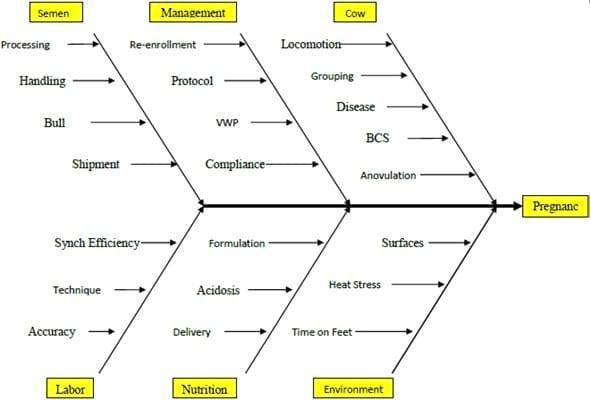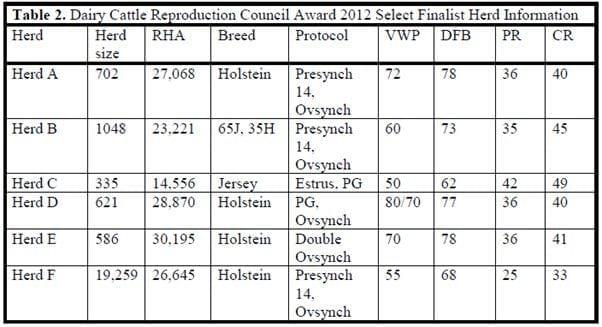Hormone strategies for fertility improvement
Published: February 28, 2014
By: Andy Skidmore (MSD Animal Health)
Reproductive performance has declined over the last several decades in the United States. Reproductive performance is an inter-play between management, environment and cow biological factors. See Figure 1 for a chart summarizing the many factors that influence the cause and effect of pregnancy in dairy cattle. The decline in fertility has been associated with many factors such as milk production and management efficiency associated with increasing herd size, different housing and less aggressive expression of estrus in higher producing cows. The effect has been to increase days open and reduce income associated with reproductive efficiency in dairy herds.
All of the risk factors shown in Figure 1 can be altered with the proper implementation of appropriate management strategies to improve fertility. Hormonal strategies are one alternative to manage or reduce the negative impact of many risk factors. To better understand the hormonal strategies a basic understanding of the issues is very important.
A major event in fertility is ovulation. Without ovulation nothing else matters. There are many steps and a certain sequence of events that must occur for ovulation to happen. The sequence of events is as follows:
A major event in fertility is ovulation. Without ovulation nothing else matters. There are many steps and a certain sequence of events that must occur for ovulation to happen. The sequence of events is as follows:
1. High progesterone –
a. it provides negative feedback preventing the release of GnRH.
b. it is also essential to prime the brain to be stimulated by estrogen.
2. PGF2α released – luteolysis of the CL
3. Resulting in low progesterone – removing negative feedback on the release of GnRH
4. GnRH secretion increases in higher amplitudes and frequencies
5. FSH and LH increase in amplitude
6. Estrogen increases as dominant follicle grows
a. Increasing estrogen causes inhibin to increase resulting in decreasing FSH
b. LH surge is initiated
7. Ovulation occurs
a. it provides negative feedback preventing the release of GnRH.
b. it is also essential to prime the brain to be stimulated by estrogen.
2. PGF2α released – luteolysis of the CL
3. Resulting in low progesterone – removing negative feedback on the release of GnRH
4. GnRH secretion increases in higher amplitudes and frequencies
5. FSH and LH increase in amplitude
6. Estrogen increases as dominant follicle grows
a. Increasing estrogen causes inhibin to increase resulting in decreasing FSH
b. LH surge is initiated
7. Ovulation occurs
Figure 1. Cause and Effect for Pregnancy. Adapted from ABS Cause and Effect Chart for Pregnancy Production

This is very important to understand because if any element is inadequate in amplitude or level or frequency or out of sequence then ovulation does not occur.
Anovulation is a major problem in today’s high producing dairy cow. Anovulation is defined as a cow that does not ovulate even though there is activity on the ovary and sometimes estrus behavior may be demonstrated. This is to be distinguished from anestrus which is the lack of estrus behavior and activity on the ovary. Follicles come and go but they do not ovulate for whatever reason. Because there is no ovulation there is no CL formation. Without the high levels of progesterone the cascade of events leading to ovulation are never completed. It has been observed and estimated that 30 to 40 percent of cows are anovulatory at 60 days in milk. In time, many of these cases will resolve without treatment. But time is of the essence and profits do not wait for biology to catch up.
In the case of anestrus, progesterone is necessary to initiate normal cyclicity to the ovary.
Anovulation and anestrus are difficult to diagnose on a commercial dairy. Management protocols have been implemented in the United States to manage these cows. It is assumed that cows that do not demonstrate estrus and are not detected before about 80 to 90 days in milk are anestrus or anovulatory. In the case of herds that do not do any heat detection and use ovulation synchronization as the only method of timing insemination, it is assumed that cows that do not get pregnant after 2 or 3 synchronization protocol cycles are anovulatory. These cows are then enrolled into a synchronization protocol that includes supplemental progesterone as part of the protocol.
Cystic ovaries have become a non-issue on commercial dairies in the US. With the increasing use of ultrasound it has been observed that many cows will continue to cycle normally even though there may be a cystic structure on one ovary. The treatment for a cystic cow is the ovulation synchronization protocol of your choice. So even if a herd management protocol is to use heat detection to 80 or 90 days in milk and then put all remaining cows on an ovulation synchronization protocol, all cystic cows will be receive the correct therapy in a timely manner.
Uterine health is also a major issue the impacts fertility. Calving is not a sterile process. It takes about 3 weeks normally to “clean up” the uterus and be ready for another pregnancy. Uterine disease can manifest itself in many different syndromes. The syndrome of interest in this presentation is subclinical endometritis. Subclinical endometritis presents as no visible vaginal discharge, no detectable changes on rectal examination and often the only sign is repeat breeding. It is difficult to diagnose and is only diagnosed by cytology of the uterus – >18% neutrophils at 20-33 days in milk or >10% neutrophils at 34-47 days in milk and no signs of clinical endometritis. Incidence rates of 12 to 53 percent have been reported. Decreases in first service conception rate by as much as 50 percent have been reported. Intrauterine antibiotic therapy is the only therapy to show consistent results at improving reproductive efficiency.
Estrus detection can be a challenge in today’s commercial dairy with high producing cows because they demonstrate estrus for much less lengths of time and with less intensity. This leads to the biggest reason cows do not get pregnant – a semen deficiency. It has been reported that about 30% of cows never demonstrate physical signs of estrus. Of that 30%, a third will ovulate but not show estrus (10% of the herd) and the other two-thirds are anovulatory, which means they do not ovulate. In well-controlled synchronization trials with very good compliance, it has been reported that about 20 percent of cows don’t ovulate at the time of insemination. In addition, some reports indicate that 60 percent of cows in estrus express estrus behavior between 6 p.m. and 6 a.m. when no one is working with the cows .
To overcome these challenges many different ovulation synchronization protocols have been developed. These are ovulation synchronization protocols and not estrus synchronization protocols. There is a very big yet subtle difference. In ovulation synchronization follicle development and ovulation is controlled and synchronized through hormonal therapy. In estrus synchronization hormonal therapy is used to synchronize estrus behavior which does not correspond well enough to ovulation to allow for fixed time insemination. Research continues to refine and improve on these protocols.
It is difficult to compare protocols and predict which protocol will work for any one given herd. There many variables and different resources required to successfully implement a given synchronization protocol. Table 1 provides a rough comparison of different protocols.

The protocol implemented is not near as important as compliance to said protocol. In a 5 shot protocol if only 95% (19 in 20) of the cows receive the correct dose and product at each injection cycle then only 77% of the cows will be synchronized by the time of insemination. That is in 1 of 4 cows it was a waste of time and money and the chances of getting pregnant to fixed time insemination is not very probable in those cows. Even if 99.5% (199 in 200) compliance is achieved, 2.5% of the cows will not be synchronized by the time of insemination. That is 1 in 40 are not likely to get pregnant because of noncompliance for whatever reason. And then 20% of the 39 that compliance was good, will not ovulate at the correct time.
If 99.9% was good enough
- 12 newborn babies would be given to the wrong parents in the United States
- 114.500 mismatched pairs of shoes would be shipped every year
- 2,500,000 books will be shipped with the wrong covers
- 2 planes landing at Chicago’s O’Hare airport will be unsafe every day
- 315 entries in Webster’s dictionary will be misspelled
- 20,000 incorrect drug prescriptions will be written this year
- 114.500 mismatched pairs of shoes would be shipped every year
- 2,500,000 books will be shipped with the wrong covers
- 2 planes landing at Chicago’s O’Hare airport will be unsafe every day
- 315 entries in Webster’s dictionary will be misspelled
- 20,000 incorrect drug prescriptions will be written this year
Compliance is not only necessary but essential to the successful implementation of any synchronization protocol.
It is possible to get the job done in large herds. The Reproduction Award finalists in 2012 demonstrate what can be achieved with compliance and attention to detail. See table 2.

Getting dairy cows bred back quickly is a goal of every dairy producer. Hormonal therapy strategies are one tool to help manage the challenges associated with getting cows pregnant in a timely manner and maintain the profitability of the dairy.
This paper was presented at the 12º Congreso Internacional de MVZ especialistas en Bovinos de la Comarca Lagunera, Mexico, November 2012.
Related topics:
Authors:
MSD Perú
Recommend
Comment
Share
Recommend
Reply

Would you like to discuss another topic? Create a new post to engage with experts in the community.
Featured users in Dairy Cattle

José Manuel Oropeza Meza
MSD - Merck Animal Health
Gerente Nacional Cuentas Clave en MSD Salud Animal
United States
United States








